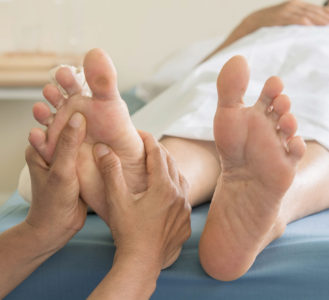 Arches come in all shapes and sizes. Some people have naturally high arches, while others have almost no arch at all. While we can’t choose our foot arch, its design plays a crucial role in how our feet support our body’s weight when it’s in motion. If pain begins to develop in your arch, don’t just ignore it, because an untreated arch issue can cause significant problems for the stability of your foot and ankle.
Arches come in all shapes and sizes. Some people have naturally high arches, while others have almost no arch at all. While we can’t choose our foot arch, its design plays a crucial role in how our feet support our body’s weight when it’s in motion. If pain begins to develop in your arch, don’t just ignore it, because an untreated arch issue can cause significant problems for the stability of your foot and ankle.
In today’s blog, we take a closer look at common problems that can develop in your foot arch, and we walk you through some treatment options.
Common Arch Problems
Pain or discomfort in the arch of your foot tends to happen for one of two reasons – direct injury or structural abnormality. Both of these factors can also play a role in a singular injury, in that a structural defect can cause an acute injury to occur. Moreover, there are also a couple of factors that can increase your risk of developing arch issues, only some of which you can control. Those factors include:
- Age
- Weight
- Genetics
Here’s a look at three foot conditions that can lead to arch pain:
Plantar Fasciitis – Plantar fasciitis is a condition we have profiled numerous times on our blog, and it is caused by inflammation and tearing of the thick band of tissue under your arch called the plantar fascia. The plantar fascia is designed to help connect the toes to your heel bone, and is also supports the arch of your foot. Due to repetitive stress and overuse, inflammation of the band can develop, leading to significant arch pain. Rest can sometimes help calm symptoms, but more aggressive treatment is usually recommended. Weight loss, modified exercise activities and targeted physical therapy can all help you put your plantar fasciitis behind you for good.
Posterior Tibial Tendon Dysfunction – Posterior tibial tendon dysfunction is a condition that involves a problem with the tendon that runs from the calf muscle to the inner portion of your foot. Changes in the tendon can limit its ability to support the arch of your foot, oftentimes leading to a decreasing arch or flat feet syndrome. Custom orthotics to provide more support combined with strength training physical therapy are common ways to treat PTTD.
Cavus Foot – Cavus foot is the final arch issue we’re focusing on, and it can actually lead to very high arches. It’s a condition that is more common in patients with cerebral palsy, after a stroke or in combination with another neurological disorder, but it leads to high arches and excessive pressure on the ball and heel of the foot. Custom shoes and bracing are designed to help take pressure off these areas of your feet, but if they prove unsuccessful, a surgical operation to stabilize the arch and the foot may be necessary.